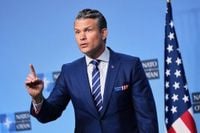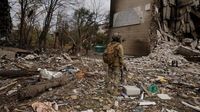On October 15, 2025, as the war in Ukraine grinds toward its fourth winter, a new wave of military pledges and political maneuvering swept across Brussels. Germany, NATO’s largest European economy, stepped forward with a promise of more than $2 billion in military aid for Ukraine, a move that comes as Kyiv’s leaders warn of dire needs and dwindling foreign support. The announcement, made by German Defense Minister Boris Pistorius, signals a renewed push among some European allies to bolster Ukraine’s defenses at a time when overall Western assistance is on the decline.
Germany’s latest commitment is both broad and urgent. According to the Associated Press, the package will include a host of advanced weaponry: air defense systems, Patriot missile interceptors, radar systems, precision-guided artillery, rockets, and ammunition. Notably, Germany will also provide two Iris-T air defense systems—complete with guided missiles—as well as shoulder-fired anti-air missiles, anti-tank weapons, communication devices, and hand-held arms. Pistorius stressed that the aid “addresses a number of urgent requirements of Ukraine,” underscoring the immediacy of the threat posed by Russia’s relentless air campaign.
Germany’s new pledge is part of a broader NATO initiative known as the Prioritized Ukraine Requirements List, or PURL. This fast-track funding program, launched over the summer, is designed to ensure that Ukraine receives at least one substantial shipment of military support per month, each worth around $500 million. With European arsenals running low—many countries have nearly exhausted their spare weapons stocks—the alliance has increasingly turned to the United States, which still maintains an estimated $10–$12 billion in arms and ammunition suitable for Ukraine’s needs.
Under PURL, European allies and Canada are pooling their resources to buy American weapons for Ukraine. Since August, about $2 billion has been allocated through this arrangement. The latest German commitment includes $500 million earmarked specifically for U.S.-made weapons. Estonia, Finland, Lithuania, and Sweden have all announced plans to participate in the funding initiative, with Finland’s Defense Minister Antti Häkkänen stating, “We see that it’s crucial that Ukraine gets the critical U.S. weapons.” Finland will also provide a separate package of its own military equipment, while Sweden’s Defense Minister Pål Jonson declared, “Sweden stands ready to do more.”
Despite these renewed efforts, the overall trajectory of Western aid has been troubling. According to data from Germany’s Kiel Institute, foreign military support for Ukraine plunged by 43% in July and August compared to the first half of the year. This sharp decline has raised alarms among NATO officials and Ukraine’s backers. “This is critical now because we’ve been seeing the wrong trajectory when it comes to support to Ukraine, that it’s been going down and we want to see more stepping up,” Jonson told reporters at NATO headquarters, as reported by AP.
Ukraine’s own defense needs have only grown more acute. At the NATO defense ministers’ meeting in Brussels, Ukrainian Defense Minister Denys Shmyhal laid out a stark assessment: Ukraine will require $120 billion in military support for 2026 alone. “Ukraine will cover half, $60 billion, from our national resources. We are asking partners to join us in covering the other half,” Shmyhal said, urging allies to dedicate at least 0.25% of their GDP to military assistance for Kyiv. The most urgent priority, he stressed, is air defense. “Last month alone, Russia launched over 5,600 strike drones and more than 180 missiles targeting our civilian infrastructure and people. Therefore, on the eve of winter, it is very critical to provide us with necessary equipment to repel such attacks.”
The need for robust air defenses is especially pressing as Russia intensifies its campaign against Ukraine’s power grid, aiming to leave civilians without heat and water as temperatures drop. According to Euronews, Moscow’s annual winter offensive is designed to cripple Ukraine’s infrastructure and sap civilian morale. Meanwhile, a recent spate of mysterious drone incursions and airspace violations by Russian warplanes has heightened concerns that President Vladimir Putin may be probing NATO’s defensive reflexes—and possibly waging a hybrid war across Europe, a charge Moscow denies.
These developments have added urgency to NATO’s internal debates. At the Brussels meeting, defense ministers also discussed whether to lift restrictions on the use of NATO aircraft and other equipment deployed along the alliance’s eastern border with Russia, Belarus, and Ukraine. NATO Secretary General Mark Rutte voiced frustration with so-called “national caveats”—rules that limit how and when allied military assets can be used. “We still have some of these national caveats and they are holding us back. They are making us less effective,” Rutte told lawmakers in Slovenia earlier this week. U.S. NATO envoy Matthew Whitaker echoed the sentiment, warning that such restrictions “make us less effective, especially our fighter jet assets.”
NATO has already set up several air defense operations along its eastern flank, including the Eastern Sentry mission, which was launched after Russian drones entered Polish airspace. U.S. Lieutenant General Alex Grynkewich, NATO’s Supreme Allied Commander, believes the alliance’s response so far has been “text book,” but he is pushing for greater flexibility and unified rules of engagement to create a more seamless air shield across the region.
Yet, for all the talk of unity, cracks remain. Criticism has mounted that France, Italy, and Spain are not contributing their “fair share” to Ukraine’s defense. Häkkänen called on all 32 NATO allies to step up, saying, “Everyone has to find the money because this is a crucial moment.” France, in particular, remains staunchly opposed to the PURL program, insisting that European funds should support the continent’s own defense industry rather than flow to American arms manufacturers. Italy and Spain, meanwhile, cite economic woes and other priorities, with Spain arguing that it compensates for lower spending by deploying troops on NATO missions.
Even as some countries hesitate, others are doubling down. Denmark, the Netherlands, Norway, and Sweden have all joined the growing list of nations buying U.S. weapons for Ukraine. The Trump administration, for its part, has not donated military equipment to Kyiv and continues to weigh whether to send Tomahawk long-range missiles—though questions remain about who would foot the bill if such a transfer is approved.
Amid these complex dynamics, U.S. Defense Secretary Pete Hegseth delivered a blunt reminder of what’s at stake: “All countries need to translate goals into guns, commitments into capabilities and pledges into power. That’s all that matters. Hard power. It’s the only thing belligerents actually respect.”
As winter approaches and the war’s toll mounts, the question for NATO and its allies is whether new pledges and shifting strategies will be enough to sustain Ukraine—and deter Russia—through another season of uncertainty and danger.





